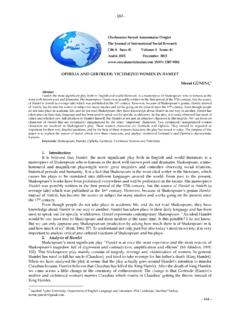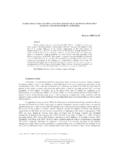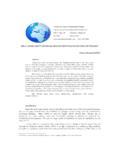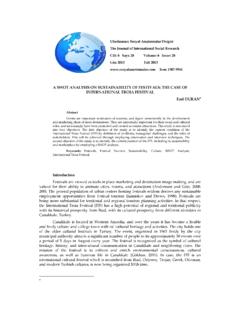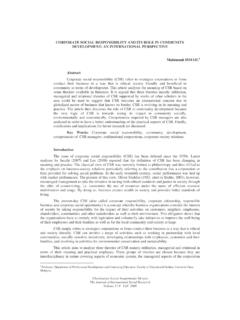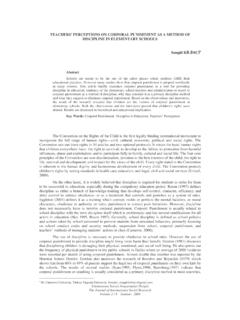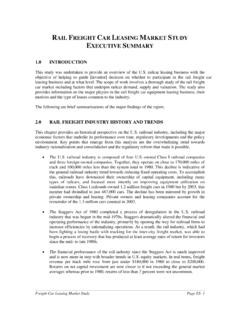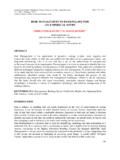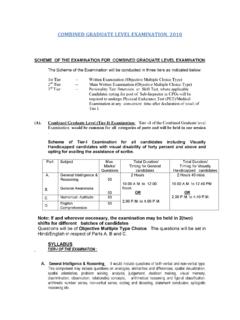Transcription of HUMAN CAPITAL DEVELOPMENT AND ITS IMPACT ON …
1 HUMAN CAPITAL DEVELOPMENT AND ITS IMPACT ON FIRM PERFORMANCE: EVIDENCE. FROM DEVELOPMENTAL ECONOMICS. Maran MARIMUTHU* . Lawrence AROKIASAMY*. Maimunah ISMAIL**. Abstract HUMAN CAPITAL is getting wider attention with increasing globalization and also the saturation of the job market due to the recent downturn in the various economies of the world. Developed and developing countries put emphases on a more HUMAN CAPITAL DEVELOPMENT towards accelerating the economic growth by devoting necessary time and efforts. Thus HUMAN CAPITAL DEVELOPMENT is one of the fundamental solutions to enter the international arena. Specifically, firms must invest necessary resources in developing HUMAN CAPITAL which tend to have a great IMPACT on performance. This paper examines the extent to which HUMAN capitals have direct impacts on firm performance from various critical perspectives.
2 Firm performance is viewed in terms of financial and non-financial performance. Finally, this paper develops a model that explains the relationship between HUMAN CAPITAL and firm performance. Key Words: HUMAN CAPITAL , firm performance and workforce. Introduction In current global market, companies are composed by competitors, regardless of industry. To develop a competitive advantage, it is important that firms truly leverage on the workforce as a competitive weapon. A strategy for improving workforce productivity to drive higher value for the firms has become an important focus. Firms seek to optimize their workforce through comprehensive HUMAN CAPITAL DEVELOPMENT programmes not only to achieve business goals but most important is for a long term survival and sustainability.
3 To accomplish this undertaking, firms will need to invest resources to ensure that employees have the knowledge, skills, and competencies they need to work effectively in a rapidly changing and complex environment. In response to the changes, most firms have embraced the notion of HUMAN CAPITAL has a good competitive advantage that will enhance higher performance. HUMAN CAPITAL DEVELOPMENT becomes a part of an overall effort to achieve cost-effective and firm performance. Hence, firms need to understand HUMAN CAPITAL that would enhance employee satisfaction and improve performance. Although there is a broad assumption that HUMAN CAPITAL has positive effects on firms' performance, the notion of performance for HUMAN CAPITAL remains largely untested. Hence, this paper attempts to look into the connection between HUMAN CAPITAL and firm's performance in the developmental economics.
4 Therefore, the following research question is used to guide our investigation: To what extent does HUMAN CAPITAL create IMPACT on firm performance? While much of the argument in the literature in terms of factors contributing to performance, this paper looks at one of the factors HUMAN CAPITAL . Firm performance is a common issue in any organizations * Senior Lecturer , Universiti Tunku Abdul Rahman. ** Professor, Universiti Putra Malaysia Uluslararas Sosyal Ara t rmalar Dergisi The Journal of International Social Research Volume 2 / 8 Summer 2009. 266 M. MARIMUTHU L. AROKIASAMY M. ISMAIL. in Malaysia especially in the new era of globalization, where competitiveness and innovativeness are norms that go with performance. This literature-based paper begins by defining the concepts of HUMAN CAPITAL and firm performance.
5 It then explores the HUMAN CAPITAL theory and connection between HUMAN CAPITAL and firm performance. In the final section we develop the model and conclude the significance of the HUMAN CAPITAL as a pillar in future analysis of firm performance. Definition of HUMAN CAPITAL and Firm Performance What is HUMAN CAPITAL ? According Schultz (1993), the term HUMAN CAPITAL has been defined as a key element in improving a firm assets and employees in order to increase productive as well as sustain competitive advantage. To sustain competitiveness in the organization HUMAN CAPITAL becomes an instrument used to increase productivity. HUMAN capitals refer to processes that relate to training, education and other professional initiatives in order to increase the levels of knowledge, skills, abilities, values, and social assets of an employee which will lead to the employee's satisfaction and performance, and eventually on a firm performance.
6 Rastogi (2000) stated that HUMAN CAPITAL is an important input for organizations especially for employees' continuous improvement mainly on knowledge, skills, and abilities. Thus, the definition of HUMAN CAPITAL is referred to as the knowledge, skills, competencies, and attributes embodied in individuals that facilitate the creation of personal, social and economic well-being (Organization for Economic Co-Operation and DEVELOPMENT or OECD, 2001: 18). The constantly changing business environment requires firms to strive for superior competitive advantages via dynamic business plans which incorporate creativity and innovativeness. This is essentially important for their long term sustainability. Undoubtedly, HUMAN resource input plays a significant role in enhancing firms' competitiveness (Barney, 1995).
7 At a glance, substantial studies were carried out on HUMAN CAPITAL and their implications on firm performance were widely covered and obviously, HUMAN CAPITAL enhancement will result in greater competitiveness and performance (Agarwala, 2003; Guthrie et al., 2002). Meantime, there is a significant relationship between innovativeness and firm performance under the HUMAN CAPITAL philosophy (Lumpkin & Dess, 2005). In relation to this, the definition of firm performance could vary from one and another. Nonetheless, some clear definitions of firm performance in the context of HUMAN CAPITAL enhancement could be put forward. In some cases, financial performance measures such as percentage of sales resulting from new products, profitability, CAPITAL employed and return on assets (ROA) (Selvarajan et al.)
8 , 2007; Hsu et al., 2007). Besides, return on investment (ROI), earnings per share (EPS) and net income after tax (NIAT) can also be used as measures of financial performance (Grossman, 2000). Interestingly, researchers also tend to benchmark managerial accounting indicators against the financial measures in six dimension; workers compensation'. (workers' compensation expenses divided by sales); quality' (number of errors in production); shrinkage'. ( inventory loss, defects, sales return); productivity' (payroll expenses divided by output); operating expenses' (total operating expenses divided by sales) (Wright et al., 2005). On the other hand, firm performance can also be measured using perceived performance approach' (also referred to as subjective performance measure) where Likert-like scaling is used to measure firm performance from the top management perspectives (Selvarajan, 2007).
9 HUMAN CAPITAL Theory The theory of HUMAN CAPITAL is rooted from the field of macroeconomic DEVELOPMENT theory (Schultz, 1993). Becker's (1993) classic book, HUMAN CAPITAL : A Theoretical and Empirical Analysis with special reference to education, illustrates this domain. Becker argues that there are different kinds of capitals that include schooling, a computer training course, expenditures on medical care. And in fact, lectures on the virtues of punctuality and honesty are CAPITAL too. In the true sense, they improve health, raise earnings, or add to a person's appreciation of literature over a lifetime. Consequently, it is fully in keeping with the CAPITAL Uluslararas Sosyal Ara t rmalar Dergisi The Journal of International Social Research Volume 2 / 8 Summer 2009.
10 HUMAN CAPITAL DEVELOPMENT and Its IMPACT on Firm Performance: Evidence from Developmental Economics 267. concept as traditionally defined to say that expenditures on education, training, and medical care, etc., are investment in CAPITAL . These are not simply costs but investment with valuable returns that can be calculated. From the perspective of Classical Economic Theory, HUMAN CAPITAL considers labour as a commodity that can be traded in terms of purchase and sale. This classical theory very much focuses on the exploitation of labour by CAPITAL . However, unlike the meaning traditionally associated with the term labour, HUMAN CAPITAL refers to the knowledge, expertise, and skill one accumulates through education and training. Emphasizing the social and economic importance of HUMAN CAPITAL theory, Becker (1993) noted the most valuable of all CAPITAL is that investment in HUMAN being.

